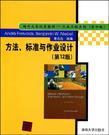方法、标准与作业设计
出版时间:2009-7 出版社:清华大学 作者:(美)弗瑞瓦兹|改编:李志忠 页数:722
Tag标签:无
前言
本教材系列的出版正值中国学术界工业工程学科经历巨大发展、实际工作中对工业工程的概念、方法和工具的使用兴趣日渐浓厚之时。在实际工作中有效地应用工业工程的手段将无疑会提高生产率、工作质量、合作的满意度和效果。 该系列中的书籍对工业工程的本科生、研究生和工业界中需要解决工程系统设计、运作和管理诸方面问题的人士最为适用。
内容概要
本书系统地介绍了操作与过程分析、问题解决方法、决策方法、改善方案实施、动作与时间研究、作业取样及其标准化、薪酬制定、培训等实用性非常强的工业工程与现场改善的理论与方法。 本书从合理的工程方法、符合实际的作业标准以及公正的薪金报酬等3个方面为制造业和服务业等的管理提供了最基本的理论和方法,并辅以应用案例、习题和在线支持,是一本值得推荐的教材。全书实用性强,语言流畅,通俗易懂,适合工程类学科的本科生、研究生以及制造业和服务业的工程技术人员与管理者学习和借鉴。
书籍目录
Pretace Chapter 1 Methods,Standards,and Work Design:Introduction 1.1 Productivity Importance 1.2 Methods and Standards Scope 1.3 Historical Developments Summary Questions References Websites Chapter 2 Problem-Solving Tools 2.1 Exploratory Tools 2.2 Recording and Analysis Tools 2.3 Quantitative Tools.Worker and Machine Relationships Summary Questions Problems References Selected Software Chpater 3 Operation Analysis 3.1 Operation Purpose 3.2 Part Design 3.3 TOlerances and Specifications 3.4 Material 3.5 Manufacture Sequence and Process 3.6 Setup andTools 3.7 Material Handling 3.8 Plant Layout 3.9 Work Design Summary Questions Problems References Selected Software Selected Videotapes/DVDSChapter 4 Manual Work Design 4.1 The Musculoskeletal System 4.2 Principles of Work Design:Human Capabilities and Morion Economy 4.3 Morion Study 4.4 Manual WOrk and Design Guidelines Summary Questions Problems References Selected Software Websites Chapter 5 Workplace,Equipment,and Tool DesignChapter 6 Work Environment DesignChapter 7 Design of Cognitive Work Chapter 8 Workplace and Systems SafetyChapter 9 Proposed Method ImplementationChapter 10 Time StudyChapter 11 Performance Rating and AllowancesChapter 12 Standard Data and FormulasChapter 13 Predetermined Time SystemsChapter 14 Work SamplingChapter 15 Indirect and Expense Labor StandardsChapter 16 Standards Follow-up and UsesChapter 17 Wage PaymentChapter 18 Traning and Other Management PracticesAppendix 1:GlossaryAppendix 2:Helpful FormulasAppendix 3:Special TablesIndex
章节摘录
Successful methodschanges implemented included water jet cutters in place of manual trimming of thecarpets with knives, a decrease in the number of times the carpets were handledmanually with excessive pinch grips, and changes in gluing and sewing operations.In addition, the working conditions through the employees perspective were ana-lyzed with a health and safety survey, and the workers were provided with variouslevels of ergonomics training. As a result, the number of OSHA-recordable mus-culoskeletal injuries dropped from a high of 55 in the first year, to 35 in the secondyear, to 17 in the third year, and to an eventual low of 8 in the fifth year. However,more important, the ergonomics program was considered so successful by OSHAthat the abatement program oversight was terminated after the second year!SUMMARY Increased output and improved quality are the primary outcomes of methods andwork design changes, but methods changes also distribute the benefits of im-proved production to all workers and help develop better working conditions anda safer working environment, so the worker can do more work at the plant, do agood job, and still have enough energy to enjoy life. The examples of effectiveimplementation of methods changes clearly demonstrate the need to follow anorderly approach, as presented in Figure 2.1. The methods engineer should notethat it is not sufficient to use sophisticated mathematical algorithms or the latestsoftware tools to develop the ideal method. It is necessary to sell the plan both tomanagement and to the workers themselves. Additional interpersonal techniquesand strategies for dealing with people to better sell the method are presented in Chapter 18. QUESTIONS 1. Compare and contrast a decision table with value engineering. 2. How does one define the benefits especially related to health and safety in cost-benefit analysis? 3. What are the principal concerns of management with regard to a new method that isrelatively costly to install? 4. What is meant by the discounted cash flow method? 5. What is meant by the payback method? How is it related to the return oninvestment method? 6. What is the relationship between return on capital investment and the riskassociated with the anticipated sales of the product for which a new method willbe used? 7. What two specific subjects should be emphasized in writing the job description? 8. Is time a common denominator of labor cost? Why or why not? 9. What is a job evaluation? 10. Which four methods of job evaluation are being practiced in this country today? 11. Explain in detail how a point plan works.
图书封面
图书标签Tags
无
评论、评分、阅读与下载
用户评论 (总计13条)
- 是一本好书,但是专业英语要过关哦。我没有一点工业工程基础,看着有点吃力。刚看前几页的时候非常有心有灵犀的感觉。所以又买了本翻译版的。两本对照着看。原版的讲解要好过翻译版的,深入浅出。因为有很多地方我看翻译版的看不懂,但是拿出原版的来,就知道压根没那么绕。还有就是这本书不太适合自学,最好有人引导。我就是自学的,相当吃力。建议英文好且有耐心的就看原版的。
- 工业工程的经典教材,鼓励这种出版方式,原版的实在太贵了。
- 英文版很好!工業工程人士合適閱讀!
- 推荐中英文配套购买,能很好的扩充知识和锻炼英文水平。
不过对于学生来说,价格还是有点贵。 - 和我们在使用的高教版有明显的 侧重点!
- 书的质量挺好物流也很给力,全英文的英语不是很好看的很费力
- 经典教程,受益匪浅
- 有一页存在油污,不过应该是印刷时的失误,不影响阅读
- 打开书,满眼的英文,恩,是提高英文的好时候。。。。。加油
- 后悔没买翻译版的了
- 书不错,还没读。很厚。
- 书是很不错的,但是缺憾是其中第5章到第8章都给删掉了,要是买到的是全本就好了。
- 全都是英文,我英文不好,看不懂!!能否更换?
